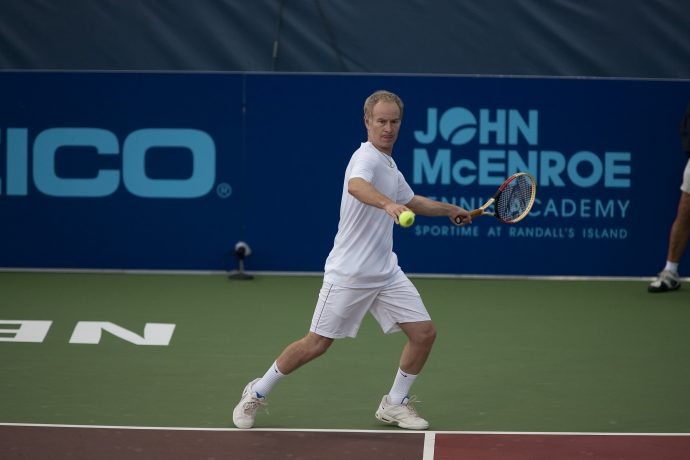Tucked away in a corner of Lake Isle Country Club in Eastchester – which bustles with athletic activity on a bright, sweltering day – is Sportime Lake Isle, which bills itself as “lower Westchester’s premier tennis destination.” It’s a club program in which you or I can hone our backhands.
But Sportime Lake Isle is also home to the John McEnroe Tennis Academy, where juniors (under age 18) who are serious about learning the game and excelling competitively can get the training they need.
“John lives in Manhattan, so he opened his academy four years ago on Randall’s Island,” says Fritz Buehning, director of tennis at Sportime and annex director of the academy. “That’s the flagship. He opened the academy at Lake Isle in September 2012, and there’s also one in Bethpage on Long Island.”
Sportime – which leases the property from the town of Eastchester, owner of Lake Isle – put $6.5 million into creating a facility with a cheery, contemporary 5,000-square-foot clubhouse and eight Har-Tru courts. McEnroe – a former world No. 1 singles and doubles player who serves as a commentator for NBC and plays on what he calls “the old fogeys’ tour” – still finds time to coach regularly at his academies.
He has done all this, Buehning says, “so that good players from the eastern section of the country don’t have to leave their homes and schools to be able to get good coaching.”
Both McEnroe and Buehning – a former tennis pro who was ranked No. 21 in singles and No. 4 in doubles, he and Van Winitsky having lost the 1983 US Open doubles final ironically to McEnroe and Peter Fleming – were the beneficiaries of coaching in their own backyard. They, along with Fleming, Vitas Gerulaitis, Mary Carillo and Peter Rennert attended Port Washington Tennis Academy, where the legendary coaches included Tony Palafox and Harry Hopman.
For Buehning and Harel Srugo – general manager of Sportime Lake Isle and associate director of its academy – tennis is a serious business. Students as young as age 5 begin with the Pathway Red programs (larger, lower compression red balls, smaller rackets, a 36-foot court) and progress to the Pathway Orange programs (orange balls, 60-foot court) and then on to green and finally the regulation yellow balls. The number of times the students play is important, Buehning and Srugo say. The academy recommends a minimum of two two-hour clinics a week, plus a one-hour private lesson. That’s in addition to two tournaments a month. Many of the players are training more than nine hours a week, doing their homework on their way to and from the courts, which are under protective bubbles in winter.
Cross-training is also encouraged – “anything that involves running and a ball,” says a laughing Srugo, who still competes on the ATP Challenger Tour and the ITF Futures as a singles and doubles player. Growing up in Israel, Srugo also played basketball and soccer.
“Playing other sports helps your coordination and conditioning,” Buehning says, adding that the best complement to tennis is soccer. And what of recent reports linking soccer players’ proclivity to head the ball to subconcussions and brain damage?
“Things will happen in any sport,” Buehning says. “You protect children and players with proper movement and technique.”
Fortunately, there are not too many, if any, concussions in tennis. But there are muscle and joint problems that result increasingly from what has become a power game. (See related story.) And then there is the psychological aspect. Perhaps more than any other sport, tennis is a game that ultimately rests on the (sometimes fragile) psyche of the individual.
“We’re teaching life lessons,” Buehning says of the staff of 11, “skills of listening, decision-making.”
“Time management,” Srugo says, “so (the students) can deal with their schoolwork. …One of the biggest skills is leadership, taking responsibility for what happens on the court.”
The players, Buehning says, have to learn to fight to win. But once the match ends, they also have to own the victory or defeat and let it go.
“Tennis,” he adds, “is not for the faint of heart.”
Nor is it cheap. Parents may have to lay out some $15,000 for a 32-week program, although there are scholarships and club discounts.
Among those who’ve come through the academy is Ossining’s Jamie Loeb, the No. 1 female college player, who’s considered a blue chip prospect by TennisRecruiting.net. At the 2013 US Open, she competed in the Main Draw Qualifier, defeating Veronica Cepede Roug (No. 193 at that time) 6-1, 6-3.
Another of Tennis Recruiting’s blue chip prospects is Noah Rubin, who trains at the McEnroe Academy on Randall’s Island and received text messages from Mac himself on his way to winning the boys’ singles final at Wimbledon over fellow American Stefan Kozlov, 6-4, 4-6, 6-3.
“You can see it in their eyes, if they have it,” Srugo says of the heart and art of a champion.
And then you know.
For more, visit http://www.sportimeny.com/lake-isle.





